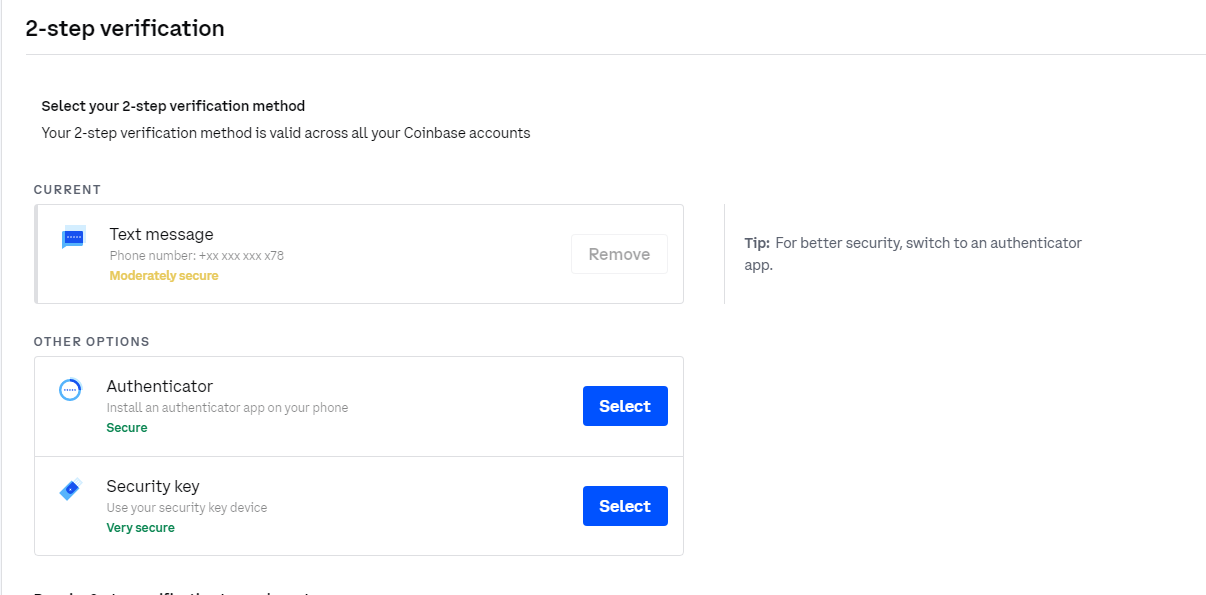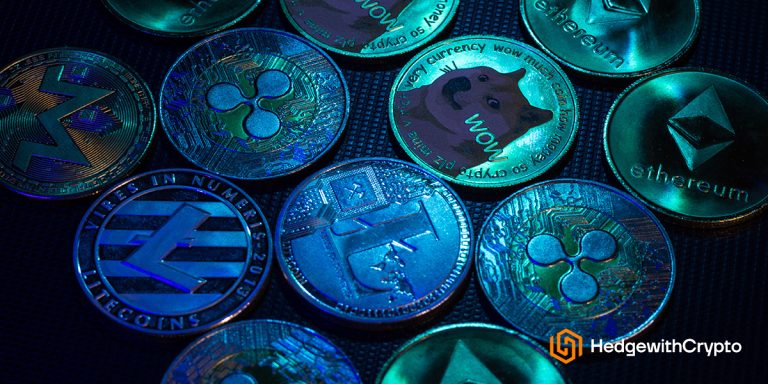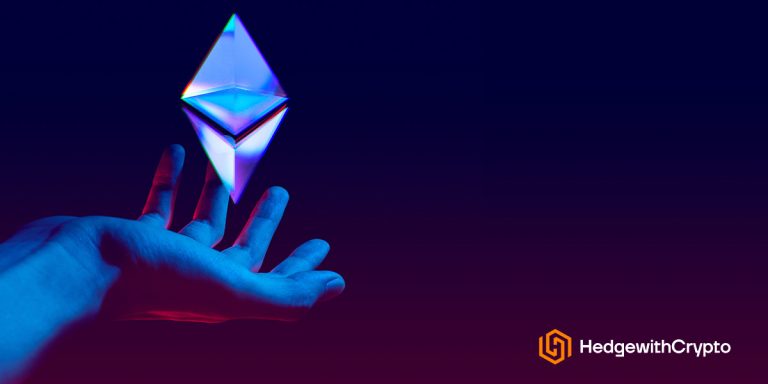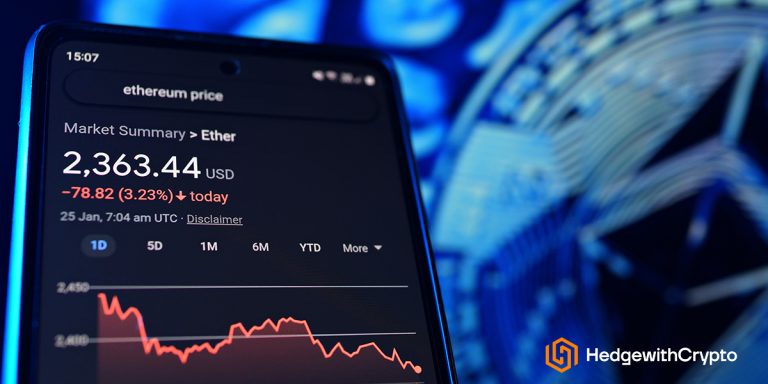We may earn a commission from links on our site, but this doesn’t affect our reviews. Learn more.
Hedge With Crypto is an independent publisher that provides objective and free content. Articles on our site may include links to our partners. If you click on these links, we may earn a commission. However, our editorial content remains unbiased, reflecting our own opinions or the general information available. For more information on our company policies, read the Affiliate Disclosure, Privacy Policy, and Terms & Conditions.
Where & How To Buy Ethereum
Hedge With Crypto aims to publish information that is factual and accurate as of the date of publication. For specific information about a cryptocurrency exchange or trading platform please visit that provider’s website. This information is general in nature and is for education purposes only. Hedge With Crypto does not provide financial advice nor does it take into account your personal financial situation. We encourage you to seek financial advice from an independent financial advisor where appropriate and make your own enquiries.
TABLE OF CONTENTS
The biggest altcoin available on the market today, the market cap of Ethereum is larger than the next ten altcoins combined. Those that are thinking about getting involved in the DeFi world of Ethereum, or just want to add it to their investment portfolio, can find out exactly how to buy Ethereum in this guide.
The easiest and safest way to purchase Ethereum is using an exchange and by following these steps:
- Compare and select a crypto exchange. Find and compare cryptocurrency exchanges that are available within the specific country and support the fiat currency that is to be converted into ETH.
- Register an account with the exchange. Create an account with a crypto exchange using a valid email address or mobile number. Before making a deposit in fiat currency, exchanges have a mandatory Know Your Customer (KYC) process that will need to be completed.
- Deposit funds to a wallet. Choose a payment option with the best fees and reasonable speed for the funds to arrive in the exchange wallet. The most common payment methods include a bank transfer, wire transfer, debit card, credit card and PayPal.
- Buy Ethereum. Browse the supported assets and choose Ethereum. Use the funded account to choose an amount to spend. Finalize the transaction by clicking on ‘Buy'. The amount of Ethereum will be determined at the selected Ethereum price and transferred to the ETH wallet.
Where To Buy Ethereum
Ethereum is one of the most popular cryptocurrencies accessible via nearly every exchange and brokerage on the market. Even low-volume platforms with a limited number of supported coins will likely offer ETH for purchase.
The sheer number of platforms available can be overwhelming, so potential investors should prioritize a specific feature best suited to their cryptocurrency needs. We've researched the best-rated cryptocurrency exchanges and listed some top choices below.
| EXCHANGE | CRYPTO ASSETS | TRADING FEES | RATING | PROMOTION | WEBSITE | REVIEW |
|---|---|---|---|---|---|---|
|
|
385 |
0.1% (spot) and 0.02% / 0.04% (Futures) |
Rating
We provide an overall weighted average rating out of 5 stars. Our ratings are based on objective criteria like the ease of use, fees, deposit methods, customer support and availability. Our reviews are not influenced by 3rd parties. Click here for further information about our rating methodology and a full list of categories we review against. 4.8 / 5 |
Up to $100 welcome bonus |
Visit Binance | Binance Review |
|
|
222 |
0.16% (maker) and 0.26% (taker) |
Rating
We provide an overall weighted average rating out of 5 stars. Our ratings are based on objective criteria like the ease of use, fees, deposit methods, customer support and availability. Our reviews are not influenced by 3rd parties. Click here for further information about our rating methodology and a full list of categories we review against. 4.8 / 5 |
None available at this time |
Visit Kraken | Kraken Review |
|
|
806 |
0.1% |
Rating
We provide an overall weighted average rating out of 5 stars. Our ratings are based on objective criteria like the ease of use, fees, deposit methods, customer support and availability. Our reviews are not influenced by 3rd parties. Click here for further information about our rating methodology and a full list of categories we review against. 4.6 / 5 |
Up to 500 USDT in bonuses |
Visit KuCoin | KuCoin Review |
|
|
79 |
1% |
Rating
We provide an overall weighted average rating out of 5 stars. Our ratings are based on objective criteria like the ease of use, fees, deposit methods, customer support and availability. Our reviews are not influenced by 3rd parties. Click here for further information about our rating methodology and a full list of categories we review against. 4.7 / 5 |
None available at this time |
Visit eToro Cryptocurrency is offered by eToro USA LLC (“the MSB”) (NMLS: 1769299) and is not FDIC or SIPC insured. Investing involves risk, and content is provided for educational purposes only, does not imply a recommendation, and is not a guarantee of future performance. [website domain name] is not an affiliate and may be compensated if you access certain products or services offered by the MSB. | eToro Review |
Don’t invest unless you’re prepared to lose all the money you invest. This is a high-risk investment and you should not expect to be protected if something goes wrong. Take 2 mins to learn more.
Step-By-Step Guide For Buying Ethereum
1. Compare and select a crypto exchange
The first step when adding Ethereum to a crypto portfolio is deciding which crypto exchange to use. Fiat-to-crypto (centralized) exchanges are the easiest way for most people to buy ETH, but more advanced users can utilize decentralized exchanges (DEXs), P2P platforms, or brokers.
Crypto exchanges typically come with a multi-coin wallet, making it easy to store ETH and any other digital currencies purchased. Platforms such as Coinbase also offer additional services like earning hubs which can be leveraged into passive income. Given Ethereum’s immense popularity, there is a huge range of options available, which may be a little overwhelming to new investors. To simplify the process, there are a few specific criteria worth considering:
- Fees. One of the first things any investor will look for is efficient and transparent fee structures. The vast majority of exchanges will charge transaction fees, but it’s also important to look out for withdrawal/deposit fees as well as spreads (the difference between a crypto’s buy price and its actual price).
- Regulations. Not every exchange is regulated by a local authority. This may dissuade some investors from getting involved due to the higher risks. Additionally, certain countries and states have very tight crypto regulations – notably New York and China. It is integral to double-check the exchange supports trading in your local area.
- Supported cryptocurrencies. Nearly every centralized exchange out there will list Ethereum for purchase. The exception will likely be “Bitcoin-only” platforms.
- Security. Exchange security is a huge factor when selecting a platform to purchase Ethereum. Researching whether the exchange has been hacked/exploited, whether they keep assets in cold storage and whether they support 2FA will help in making a decision.
- Customer service. Some investors, particularly the inexperienced, may want to ensure their exchange of choice has comprehensive customer support. Certain exchanges will have 24/7 live chat, whereas others may have no chat option whatsoever. It’s worthwhile researching support reviews on websites like HedgeWithCrypto or Trustpilot to determine if the exchange’s customer support will be sufficient.
For the purpose of this article, we will demonstrate buying Ether using the Coinbase platform. This is not intended as a recommendation of Coinbase, and individual investors may choose a completely separate platform depending on their specific cryptocurrency needs. That said, Coinbase is a high-volume, long-running, and well-trusted exchange that will likely be a solid choice for most individuals looking to buy ETH.
2. Register an account with the exchange
Get started by navigating to the exchange’s homepage and registering an account. To begin trading on the platform, the user will likely need a valid email address, mobile number, and relevant government documentation. Once an email and mobile number have been inputted, they will need to be verified with a unique code or by clicking a link.
New users must undergo verification to finalize the account creation process. Without passing this measure, most exchanges will not allow customers to deposit fiat currencies (such as AUD, USD, GBP, EUR, and more) into their accounts.
The verification process will vary between exchanges, though most are now automated and can be completed within a few minutes. Users will need to provide basic information such as address and date of birth, along with images showing government documentation like a driver’s license, bank statement, proof of residency, or passport. The exchange collects this information to comply with the international Know Your Customer (KYC) and Anti-Money Laundering (AML) requirements.

Once the account is verified, it is highly recommended to activate 2-factor authentication. This will make it much harder for hackers to access funds on the exchange account.
3. Deposit funds
Once the account is verified and ready to start trading, it’s time to deposit funds. For first-time investors, most exchanges offer simple-to-use deposit methods like instant bank transfer or even credit/debit card purchases. Alternatively, those with existing crypto capital can transfer their assets to the exchange’s wallet address. Also, there are minimum deposit limits to be aware of, as certain exchanges can have much higher minimum deposit limits than others.

When using Coinbase, users can choose between a number of deposit options, or alternatively, instantly purchase Ethereum by selecting ‘Buy’ and linking a credit/debit card. Depending on the region, Coinbase may not offer deposits via bank transfer (for example, in Australia the only payment method is a debit card).
The easiest way to deposit money on Coinbase is to link a payment method to your account. To do so, navigate to the ‘Profile/Settings’ tab, then simply select ‘Add Payment method’ and follow the relevant prompts.
From there, users can click ‘Add Cash’ from their Coinbase dashboard to instantly deposit funds (depending on the payment method chosen). Some banks may take up to a few days to process the transaction. This process will vary between cryptocurrency exchanges but should be relatively intuitive for most.
4. Buy Ethereum
Now the Coinbase account has funds, it’s time to purchase ETH. Most exchanges will have a list of purchasable assets under a ‘Market’, ‘Buy Now’ or similar tab. Navigate to this page, select ETH and input the amount you wish to buy.
When buying Ethereum on any platform, read the final transaction price to assess the fees. Additionally, certain exchanges will have a minimum investment amount, so take note of that, too. Experienced traders may be able to utilize advanced order options like Stop, Limit, Market, and others.
Once the order for ETH has been put through, the amount to be received should be shown. After reviewing and confirming the transaction, ETH should be added to the exchange wallet within a few minutes. If it takes longer than an hour, it may be worth reaching out to customer support.
Other Methods of Buying Ethereum
Although centralized exchanges are the simplest way to purchase Ether, there are a few alternatives that more experienced crypto investors may want to consider.
- Brokerages. Crypto brokers are quite similar to centralized exchanges, except for one key difference. Exchanges operate using an order book, which matches sellers (asks) with buyers (bids). Instead, trading on a brokerage cuts out the middleman, allowing investors to purchase ETH directly from the broker. This method of buying cryptocurrency often has a high barrier to entry and is intended for large-volume investors.
- Decentralized exchanges (DEX). More advanced crypto traders can leverage DEXs to purchase ETH. It is important to note that most DEXs do not support fiat deposits – customers will need to buy Ether using another cryptocurrency, particularly stablecoins. This process requires a third-party wallet compatible with the Ethereum network (like Metamask) and some base-level knowledge of how cryptocurrency works. DEXs often have much lower fees than traditional exchanges, however, are much riskier to use. It's therefore wise to use the bigger decentralized platforms which are more reputable and employ rigorous safety precautions.
- Peer-to-peer (P2P). Another option for purchasing Ethereum is P2P. Investors can purchase ETH from other people – family, friends, or even strangers – through word-of-mouth agreements or licensed P2P marketplaces. Using a trusted platform and trading with a trusted seller is extremely important when trading on a crypto P2P platform, as this method of buying Ethereum can leave buyers vulnerable to scams.
Is Ethereum Worth Investing In?
There’s no doubt that Ethereum has changed the landscape of blockchain technology, and its widespread influence will likely continue for years to come. When starting out in cryptocurrency, Ethereum (along with Bitcoin) is near-unanimously recommended as the first investment to make. Ethereum’s high value and volume make it a less volatile choice than other cryptocurrencies. That is not to say the price of ETH isn’t susceptible to wild swings, and on any given day it could move more than 10% in either direction.
For the most part, Ethereum has entrenched itself as the second-largest cryptocurrency in terms of market capitalization, popularity, and development. It has held this mantle for multiple years now and seems unlikely to drop any time soon.

Ethereum’s upgrade to 2.0 will play a major role in the blockchain’s long-term success. While Ethereum is close to as safe as altcoin investments go, it has long been plagued with limited scalability and high gas fees, dissuading its casual use. Investors will be hoping that a smooth transition to 2.0 will resolve many of these issues so Ethereum can deliver on its sky-high potential.
Is It Safe To Buy Ethereum?
Yes, Ethereum is one of the most popular and highest-volume cryptocurrencies out there. It can be bought from a number of trustworthy exchanges and stored in a secure wallet. However, all cryptocurrencies are extremely volatile and investors should expect drastic market swings and the potential for serious losses.
What Can You Do With Ethereum After Purchase?
When most people purchase Ethereum, they will just leave it in their exchange wallet to appreciate (or depreciate) in value until they’re ready to sell. However, this means they may be missing out on a number of opportunities. Ethereum’s blockchain is a bustling ecosystem filled to the brim with decentralized applications, earning features, and more. The network’s synonymity with decentralized finance means that ETH has perhaps the widest use case of any cryptocurrency token.
With that said, it is worth noting Ethereum’s blockchain is so congested that “gas fees” – which are essentially transaction fees – can quickly add up. To transfer Ethereum between wallets and platforms will incur such fees, and they may seriously impact potential profits from DeFi earning protocols or other applications.
1. Ethereum Staking
Ethereum is still awaiting its full-scale upgrade to 2.0 which will support native staking. However, the platform released a part of its upgrade, the Beacon Protocol, in late 2021. While this upgrade was not initially added to the Ethereum Mainnet, it did introduce staking to ETH holders. Users can either run their own node as a validator (requiring a minimum of 32 ETH), or delegate their ETH to someone else to receive additional ETH as a reward.
More than $25bn worth of Ethereum is being staked as of mid-2022. Generally, the more ETH being staked, the worse rewards for the staker. Only about 10% of Ethereum that can be staked is being staked, meaning it should have a competitive annual percentage yield (APY). Certain platforms, particularly those operating in the decentralized finance sector, can offer returns of up to 10% annually. The average yield for staking ETH is closer to 4% though.
Staking is relatively low-risk, but there are a number of pitfalls to look out for. For more information, read our guide on the best places to stake Ethereum, which also outlines the pros and cons of staking ETH 2.0.
2. Decentralized applications
Ethereum hosts over 3,000 unique dApps on its network, by far the most of any blockchain. ETH is commonly required to interact with these applications, the function of which spans a range of industries. Examples include Metamask (a wallet browser extension), UniSwap (Decentralized exchange/AMM), OpenSea (NFT marketplace), Axie Infinity (online game) and The Sandbox (metaverse platform). You can actually explore the majority of dApps on the Ethereum blockchain via this page.
3. Buy & Sell NFTs
Ethereum’s ERC-721 is still the most popular token standard for non-fungible tokens. Not only is Ether the main currency for purchasing and selling NFTs, but it is also used for minting new NFTs on the network. OpenSea, by far the world’s largest NFT marketplace, runs on Ethereum and requires most of its purchases to be made using Ether. To start collecting NFTs, buying Ethereum is one of the first steps.
4. Medium of exchange
Ethereum can be used as a medium of exchange across certain outlets and merchants globally. This is not the most efficient use of ETH due to the network’s high gas fees.
5. Earn interest on Ethereum
Ethereum’s major role in DeFi has made it a leading coin for liquidity pools. Advanced crypto users can utilize their Ether by providing it to liquidity pools or yield farming to earn passive revenue. Certain protocols exist that perform these tasks automatically, analyzing and selecting the most profitable pools to earn on ETH with. It’s worth noting these processes are much riskier than staking and are only recommended for seasoned crypto veterans.
Buying Ethereum Country Guides
Finding a suitable exchange to invest in Ethereum is an important consideration. Global exchanges may not be suitable for everyone and therefore, we have curated guides for specific countries to buy Ethereum outside of the USA.
How To Store Ethereum
If buying ETH via a centralized exchange, it’s most likely that any purchased assets will automatically be stored within a native exchange wallet. While convenient, this is not the safest way to store Ethereum and it is generally recommended long-term holders transfer their tokens into an independent wallet. There are two main wallets to choose from:
- Hot wallets. A hot wallet is any cryptocurrency wallet that is connected to the internet. This includes pretty much any wallet hosted on an exchange. However, third-party non-custodial wallets are very popular in the blockchain world and give control over crypto assets back to the investor. There are a lot of hot wallets for ETH traders to choose from, whether it be a browser extension or desktop/mobile application. Although non-custodial wallets give investors control over their assets, they still aren’t the safest option for storing ETH. As they are constantly connected to the blockchain, this leaves them vulnerable to hacks and other exploits. Metamask and AtomicWallet are two of the more popular third-party wallets. Read our Metamask review for more information on its safety.
- Cold wallets. A cold wallet is a cryptocurrency wallet that does not rely on a connection to the internet. They often take the form of a USB dongle or other similar hardware. Admittedly, storing ETH in a cold wallet can be inconvenient, as it takes much longer to send, receive and sell tokens when compared to a hot wallet. However, the extra security is worth it, especially for high-volume investors. The Ledger Nano series is one of the best Ethereum wallets on the market.
Frequently Asked Questions
Where Is The Best Place To Buy Ethereum?
Ethereum can be easily purchased from a range of reputable exchanges and brokers including Coinbase, Binance, eToro, and more. The “best” place to buy Ethereum will depend entirely on the investor’s specific cryptocurrency needs which can include supported payment methods, deposit fees, purchasing limits, trading and withdrawal fees.
Do You Have To Be 18 To Buy Ethereum?
No, you do not have to be over 18 to purchase Ethereum. Certain decentralized and traditional exchanges allow customers to sign up and trade ETH without verifying their age. However, the majority of crypto exchanges do have an 18+ age restriction on their platform, including Coinbase.
Should I Invest In Ethereum or Bitcoin?
Ethereum and Bitcoin are by far the two largest and most well-known cryptocurrencies, each with a unique set of advantages and disadvantages. The coin that’s right for a crypto portfolio will come down to the individual's own investment goals. Generally, diversification is a great tool to mitigate risk and many experts recommend investing in Bitcoin and Ethereum.




